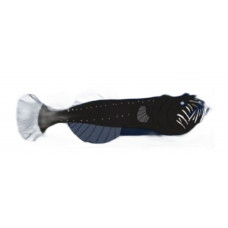Latin name
Neoceratias spinifer
Other names
Spiny seadevil, netbeard seadevil.
Identification
Possess sexual dimorphism.
Females with bare skin. The mouth is large and extends well beyond the small eye; the jaws have an inner row of short, straight, widely spaced, firmly set teeth. On the outside of the jaws are prominent conical projections with 2-3 straight teeth, the longest of which reach nearly 15% of the total body length. Each of these teeth has an articulation at the base, well-developed musculature, and a tiny hook at the end. The illicium, or lure, is absent, as is the groove in which it rests in other deep-sea anglerfish. The snout has a pair of protruding nasal papillae; nostrils and olfactory plates are absent.
Both males and larvae are distinguished from other deep-sea anglerfish by their slender bodies. They have translucent skin. Males attach to females with protuberances on the snout and lower jaw; olfactory organs are absent and the eyes are degenerated and covered with skin. Larvae have well-developed olfactory organs and lack sexual dimorphism.
Features of fish fins
10-13 dorsal fin rays; 10-13 anal fin rays; 12-15 pectoral fin rays; pelvic fins absent.
Fish colouring
Females are dark reddish brown or black. Adult males are known only from parasitic individuals already attached to females. They are lighter than females.
Distribution
It is found all over the world. In the Atlantic Ocean, it is found from New England south and east to St. Helena. In the Indian Ocean, it has been found as far north as Madagascar and the Bay of Bengal. In the Pacific, it has a wide range from the Philippines east to Hawaii, with records as far north as 32° north latitude and 133° east longitude.
Habitat
Deep water marine benthic species. The depth range is from 0 to 1200 m.
Size
Adult females have slender, elongated bodies up to 11 centimeters (4.3 inches) long. The largest known specimen of a male reaches 18 mm in length. Larvae reach 4-10 mm in length.
Behavior
Adult males parasitize females.
Food and feeding habits
These fish have no bioluminescent bait and no unusual tooth arrangement, so it is unclear what and how they feed. It has been suggested that their teeth on the outer jaws are used to catch soft-bodied invertebrates. The males are completely parasitic, using the teeth on the tips of their jaws to attach themselves to the female, and their tissues and blood vessels fuse with those of the female.
Reproduction
Spawning occurs more than once a year. The method of sexual parasitism results in the female becoming like a self-fertilizing hermaphrodite. This is due to the nature of the tissue fusion between the females and the continuous production of sperm by the male.
Fishing
Not interesting for fishermen.
Relationship with a person
A species harmless to humans.
| Classification | |
| Phylum | Chordata |
| Class | Actinopterygii |
| Squad | Lophiiformes |
| Family | Neoceratidae |
| Genus | Neoceratias |
| Species | N. spinifer |
| Features | |
| Conservation status | Least Concern |
| Habitat | Pelagic |
| Life span, years | No information |
| Maximum body weight, kg | No information |
| Maximum length, cm | 11 |
| Sailing speed, m/s | No information |
| Threat to people | Not edible |
| Way of eating | Planktonophage |
Toothed seadevil
Tags: toothed seadevil

